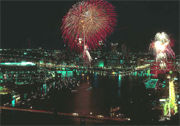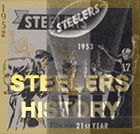THE MEMORY OF THREE RIVERS STADIUM FADES AWAY

From the cover of
the Steelers
2000 media guide

Copyright
John S. Murray
www.webshots.com

Riverside

Point Park

Article
written by STEPHEN J. DUBNER for the January 28th edition of
The New York Times
"Next week Three Rivers Stadium is being blown up. But it will live on as a testament to those four Super Bowls the Steelers won a generation ago - and to all the things Pittsburgh still wants to be."
Twenty-eight years after the Miracle, he still has the most recognizable face in town. The sharp eyes, the Roman nose, the caramel skin, the plush beard. And a regal, weary carriage, like one of the three wise men. On his way into the stadium, they paw and claw - One picture, Franco!" "I was there, Franco, just lemme shake your hand!" - and he stops for everyone. They know his face, his career stats, his provenance: one of nine children born to an Italian mother and an American soldier, a black man from Mississippi, who met in Italy at the end of the war.
Now a dusky blonde, no more than five feet tall, nearly knocks him over. "Oh, my God, it's you!" she says. "Oh, my God. Thirty years I've been waiting for this." The woman starts beating her chest with both palms. He looks perplexed for a moment, then glances down and grins. She is wearing a faded mesh Steelers shirt, No. 32, his number. "Whoa," he says. "Thirty years. Get out the mothballs."
He is dressed in an olive raincoat over a nice, greenish sports jacket, a black sweater and black trousers. His shoes are black leather - with rubber soles. The Astroturf is slick from the rain, and they are asking him to re-enact the Miracle today, one last sip of glory before they drill 2,700 holes in Three Rivers Stadium, plant the dynamite and, on Feb. 4, blow it up. He watches the last few minutes of the game from the end zone. He pulls on a crisp black No. 32 that a Steelers marketing man unpacks from a box and, when the p.a. announcer calls his name, joins the rest of his old teammates parading out to midfield under the steady throb of cheers.
Then the announcer says, "How about one more look at the greatest play in N.F.L. history - one more time!" Franco Harris, out at the 30-yard line, is tossed a football and, at maybe one-third the original speed, retraces the steps of the last-second, hair's-breadth, game-winning catch that came to be known as the Immaculate Reception. By the time he reaches the end zone, the fans are practically genuflecting. Although many of them weren't even born in 1972, the Immaculate Reception is ESPN's Zapruder film, endlessly replayed and dissected.
After the fireworks and "Auld Lang Syne," the fans file out, heads bowed. The last time they tore down a ballpark in Pittsburgh, they really tore it down. After the Pirates' final game at Forbes Field in 1970, the fans pried up their seats, stuffed chunks of turf in their pockets, tried to haul the urinal troughs out of the men's rooms. But today they behave as if they'd been invited to the deconsecration of a cathedral. Which isn't such a surprise. In Pittsburgh, the handshake between sports (particularly football) and religion (particularly Catholicism) is so firm that it can be hard to tell where one hand stops and the other begins.
At least a few Steeler fans, thanks to their equally devoted next of kin, had their ashes quietly strewn on the bright green plastic carpet of Three Rivers. But it goes beyond that. In a city of a certain size, there is nothing more important than its big-league sports teams - for revenue, for unity, for self-esteem. Sure, New York gets exercised for a Subway Series and, this week, for a Super Bowl, but it all gets swallowed up a day or two after the fact, when the next spectacle comes along. In a town like Pittsburgh, the conquests live on for years. In a town like Pittsburgh, every victory is a vote for yourself. That's why they love the Steelers so much: the Steelers are them.
The same owners for 68 years, only two coaches in the past 31, a tough-minded team that doesn't paste some silly bird or cat on its helmets. It's the steelmaking logo the Steelers wear, and only on one side. (Thrift!) Of course, nobody expected it to become an antique. On Super Bowl Sunday, it is worth remembering that somehow, beneath the blizzard of corporate sponsorship and go-go commentary, a football game gets played, and to the 45 people in pads and maybe a million or two back home, a victory means everything, forever. That's why cities like Charlotte and Jacksonville and Phoenix fight so hard to bring a team to town; it's why Cleveland and Baltimore and Pittsburgh fight so hard to keep theirs - and celebrate every victory as if it might be their last. ro football grew up in western Pennsylvania and so did half the National Football League, it seemed.
Quarterbacks especially, Unitas and Namath and Montana, but plenty of guys like Mike Ditka, people made for football. Each steel mill fielded its own team; high-school games drew 10,000 spectators. In their first 40 years, Art Rooney's Steelers were, with slight exception, dreadful. Only the Steelers could have cut a young Johnny Unitas. One of the Rooney grandkids recalls how embarrassed he was to ride to school in the family car, a Buick they got free for having "Official Car of the Pittsburgh Steelers" painted on the side.
In 1972, however, the year of the Immaculate Reception, the Steelers began a turnaround that would soon produce an unprecedented four Super Bowl titles in six years. "It was like Moses crossing the desert," says Art Rooney Jr., then a team scout. "After 40 years, you're somebody." Delirium rained down. It helped that Pittsburgh was small enough that you might run into Mean Joe Greene at the supermarket. The stars - Greene, Franco, Jack Lambert - were deities; even the kicker had a fan club. Terry Bradshaw, the mouthy young quarterback from Louisiana, he and Pittsburgh didn't always get along, but God, could he throw!
On Fridays all over western Pennsylvania, the kids wore black and gold to school. On Saturday nights, priests tripled up their Mass schedule since no one was coming on Sundays. On Monday morning, you'd walk into the hospital and all the old emphysemic steelworkers would still be going on about how the Steel Curtain smothered the Clowns - that is, the hated Cleveland Browns. And on Sundays! Well, on Sundays, Three Rivers Stadium was the place where anyone who'd ever been made to feel small just for being from Pittsburgh, which was pretty much everyone, finally got to watch his football team beat up any other city foolish enough to send in theirs.
During those six years, the Steelers won 45 games at Three Rivers and lost only 6. People painted their entire cars black and gold, without Buick even asking them. But victory came with a Faustian twist. Just as the Steelers rose, real-life steelers began to lose their jobs by the tens of thousands. So now the team was called upon to do even more: give a downward-spiraling town one thing it could trust, one thing it could be proud of. "You can't put a price tag on how valuable it was to the human spirit here," says Myron Cope, the dean of Pittsburgh sportscasters, whose style might be called Overcaffeinated Cosell.
"Wherever people gathered, the Steelers were the dominant topic. It gave people something pleasant to talk about for a change, instead of, 'Where the hell am I going to get work?"' The steel industry vanished, and the city buckled. "We had a 20-year run of bad news here, the largest population losses per capita of any area in the country," says Tom Murphy, a former seminarian and neighborhood activist who is now the mayor. "Between 1978 and 1985, we lost 150,000 jobs in heavy manufacturing alone."
So yes, the air is clean - no longer do office workers have to change their white shirts at midday - but there aren't so many people around to breathe it. The city is down to about 325,000 residents, less than half its 1950 population, and what's left is graying fast. Allegheny County has the second oldest population in the United States, after Dade; hospitals are closing their obstetrics units.
Despite some good news - boomlets in biotech and e-commerce, a leap in the city's bond rating - it's hard to hide from the bad: a monstrous debt, high taxes, whispers of bankruptcy. Only one misery could beat a bankrupt Pittsburgh: a bankrupt Pittsburgh without its sports teams.
Although the Penguins haven't won the Stanley Cup in nearly 10 years, and the Steelers and Pirates haven't gone all the way in more than 20, the Pittsburgh newspapers look like local editions of The Sporting News.
PERMISSION GIVEN BY STEPHEN J. DUBNER TO PRINT THIS ARTICLE
